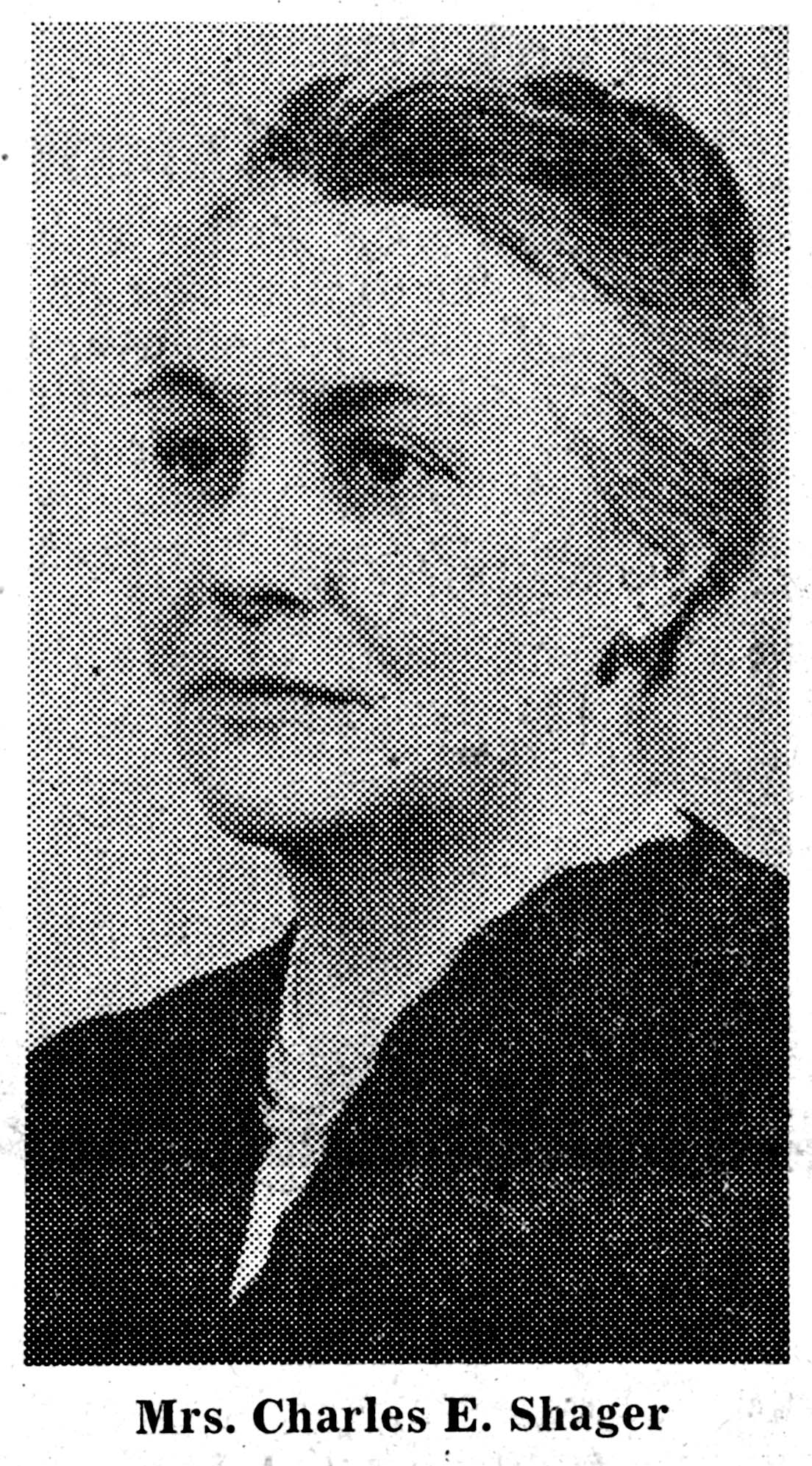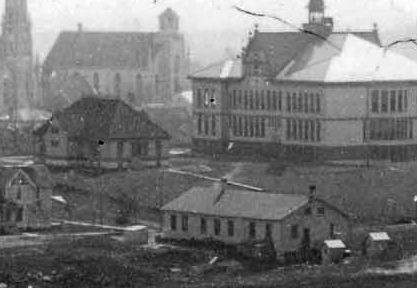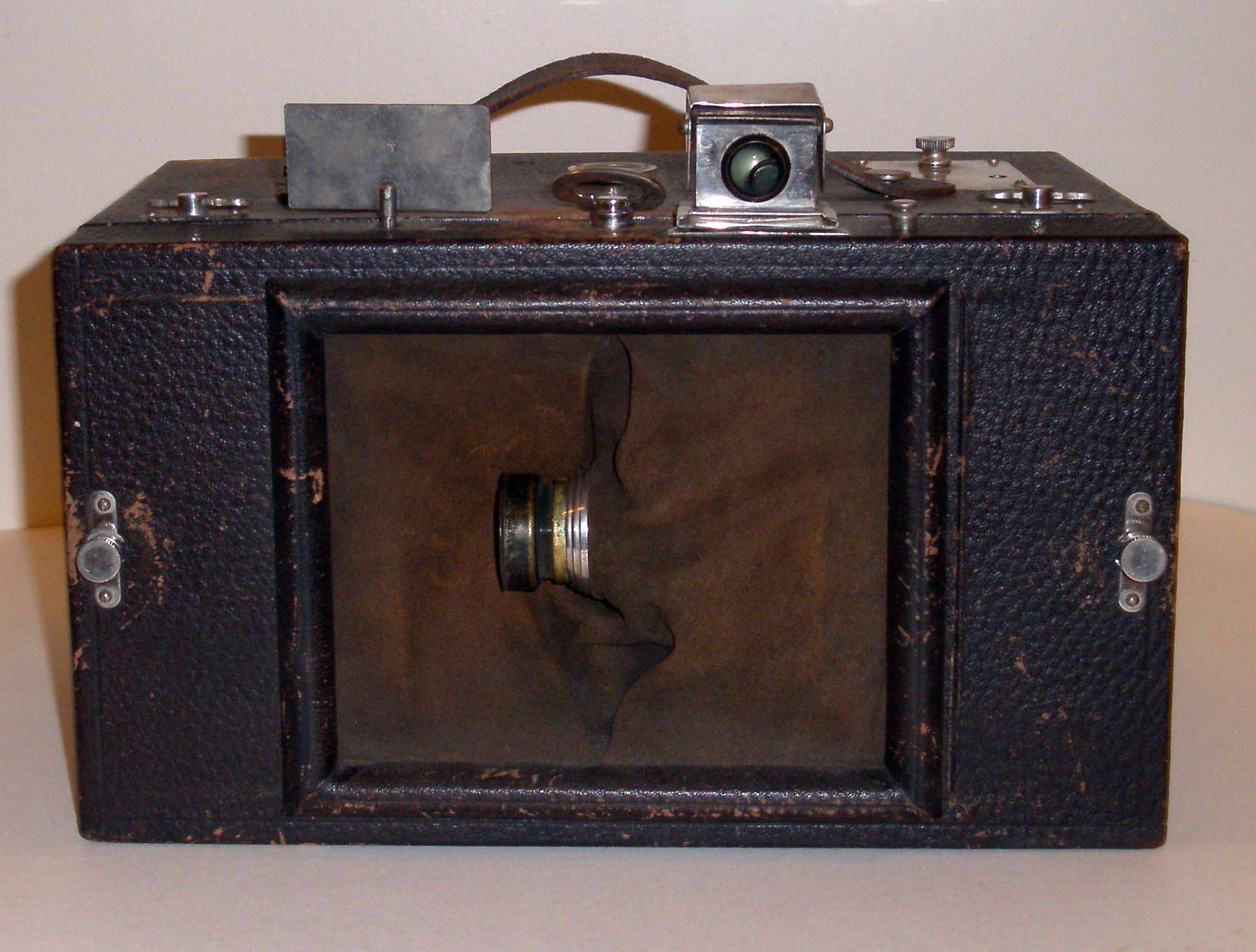Newsletter - June 2015
Burlington Historian

June 2015

Two Burlington Monuments Dedicated 80 Years Ago
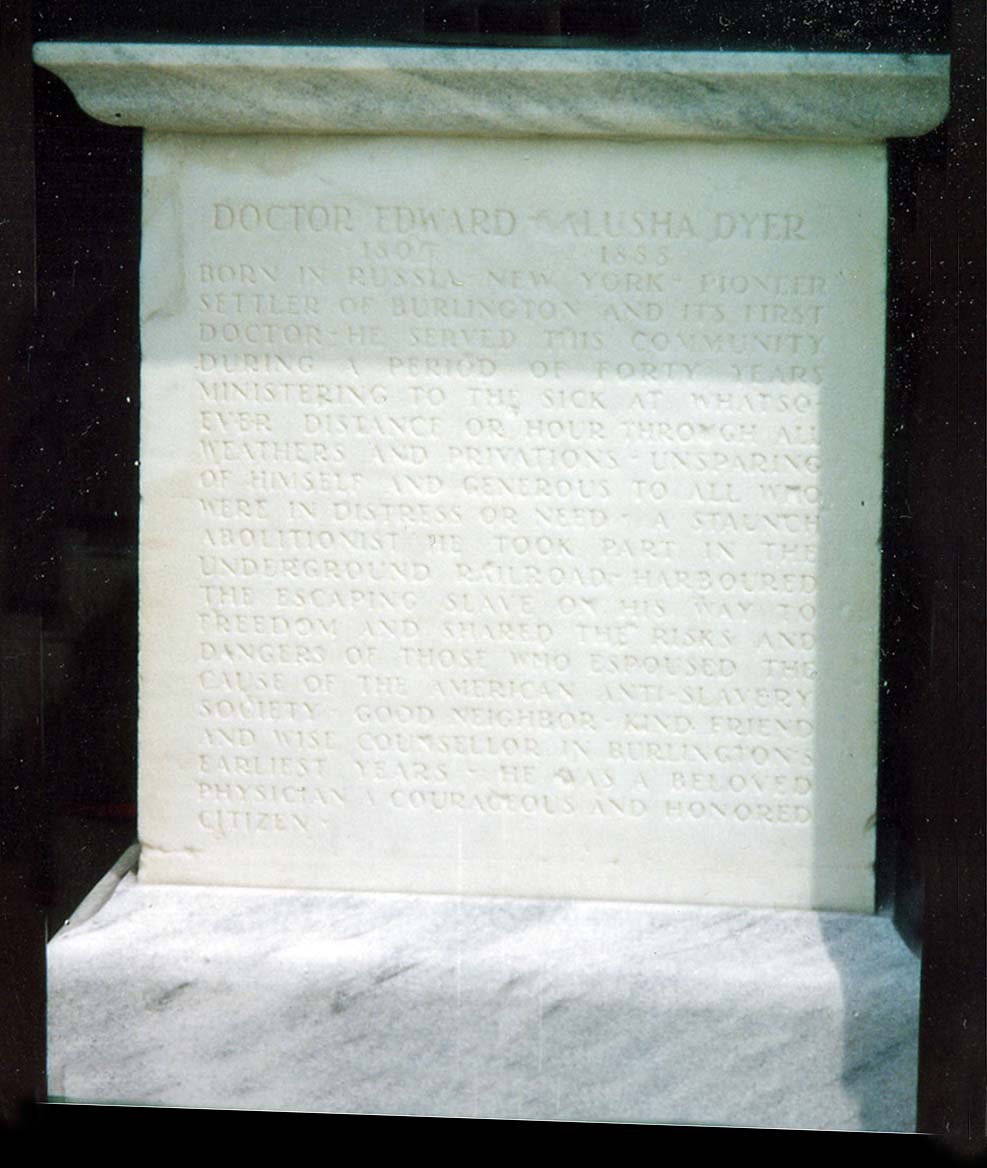
The monument honoring Dr. Dyer was donated to Burlington by Mrs. Katherine M. Norton, widow of Dr. Dyer’s grandson, Charles Dyer Norton.
Made of Colorado Yule Marble, the monument was created by Thomas Hudson Jones, who created the original Tomb of the Unknown Soldier at Arlington National Cemetery near Washington, D.C. The Dyer monument was hewn from the same stone.
The monument, topped by a sundial, was initially placed on the Lincoln School grounds facing Burlington’s Lincoln Statue. Dedication ceremonies were held on June 20, 1935.
As the monument deteriorated over many years, a new one took its place, and the original was moved to a house basement. When the house changed hands, the monument was moved to the Historical Society’s Museum garden where it further deteriorated.
As the Underground Railroad history of the Burlington area, including Dr. Dyer’s major role in that endeavor, was being developed, the Society decided to refurbish and display the original monument in front of the Museum so it would be available for viewing around-the-clock and throughout the year.
A display case was crafted by Mark Lovrine from plans drawn by Doug Lind. A plaque describing the monument was placed on the Museum wall above it.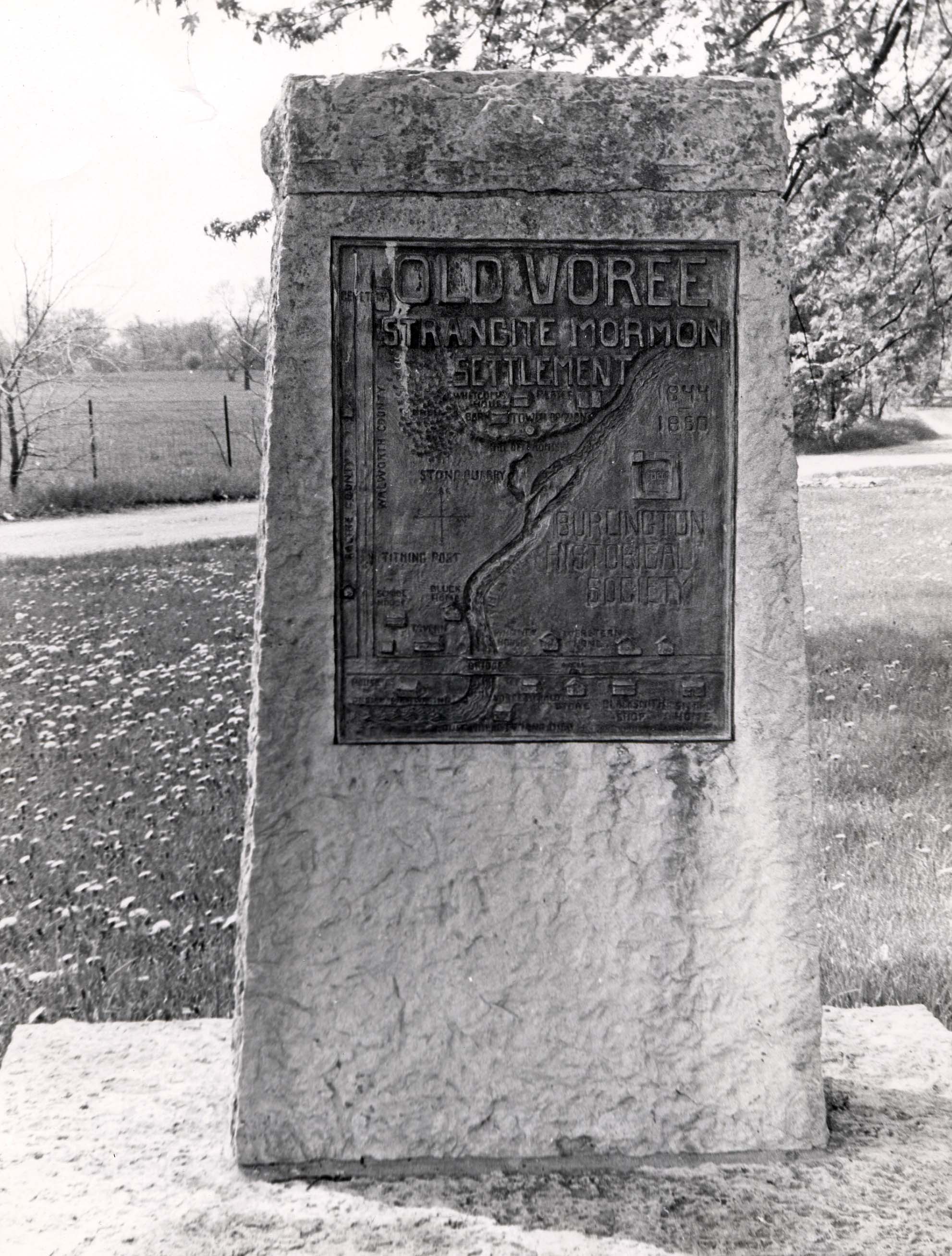 The monument commemorating the Mormon settlement of Voree and its founder, James J. Strang, resulted from a cooperative effort led by the Burlington Historical Society and joined by the Lake Geneva historical society and members of Strang’s church.
The monument commemorating the Mormon settlement of Voree and its founder, James J. Strang, resulted from a cooperative effort led by the Burlington Historical Society and joined by the Lake Geneva historical society and members of Strang’s church.
The monument sits in a small park-like area along the east bank of the White River just beyond the Mormon Road intersection with West Chestnut Street (County Trunk JS). The Society entered into a 99-year lease for the area with Mrs. Elizabeth Watson White and her sisters. Mrs. White, the daughter of Wingfield Watson, had been born on Beaver Island in Lake Michigan, where Strang and many of his followers had lived after leaving Voree.
The monument consists of three slabs of stone taken from the nearby Voree stone quarry, now the site of Burlington
. John W. Peters, then owner of the quarry, donated the stone slabs for the monument. Two of the slabs form the base while the third slab sits upright.
Attached to the upright slab are two brass plates. The north side plate contains a map of old Voree, a word which James Strang interpreted as “Garden of Peace.” The map was drawn by Edwin S. Ela, assisted by Frank Patten, Arthur Smith, and Mrs. Elizabeth Watson White. The south side plate, donated by Strang’s followers, is inscribed with commemorative words perpetuating Strang’s memory.
Both plates were crafted by Nancy Coonsman Hahn, internationally known sculptress, whose “Doughboy” in Paris, France, commemorates the American soldiers of World War I. She also sculpted “The Pioneer Woman” in St. Louis. Mrs. Hahn, along with her husband and son, lived in Burlington at various times from 1929 to the early 1940s.
The monument was dedicated on June 18, 1935, in ceremonies held, because of inclement weather, at the Conkey Street (later named Cooper) School.
President’s Message
As we get into the summer season, we find many outdoor activities around the area and our beautiful Wisconsin to enjoy.
The Burlington Farmers Market is in full swing every Thursday from 3 to 7 at Wehmhoff Square downtown. Lots of fun things to look at and loads of food and refreshments on hand. While in the park, stop by Pioneer Log Cabin and the Vintage Garden. Also, mark your calendar for Saturday, July 25, when we hold our annual Ice Cream Social in Wehmhoff Square in conjunction with the Chamber of Commerce’s Maxwell Street and Sidewalk Sales Days.
The annual Burlington Area Garden Club Walk, which will be held Sunday, July 12, starting at 10 a.m., will include a tour of the Legacy Garden adjacent to the Museum and the Vintage Garden surrounding Pioneer Log Cabin. The Museum and Cabin will be open for extended hours during the event. Tickets are available at area garden, floral, and grocery stores.
Our Society has two openings on the Board of Directors. One vacancy has existed since the death of Don Zurn early in 2014 and the other since Roger Bieneman’s recent retirement from the Board for health reasons. Both Don and Roger were actively involved in Society activities and their contributions will forever be appreciated. We need help spreading the word around town hoping to interest local parties to join our Board and get involved with the activities of historic Burlington and the Museum. Please visit the Society website – burlingtonhistory.org – for more contact information.
Enjoy the summer and be sure to get out and about as we are fortunate to have so many things to appreciate in this great area of our country.
Dennis Tully
Ice Cream Social
The Society’s annual Ice Cream Social is scheduled to be held on Saturday, July 25, near Pioneer Cabin in Wehmhoff Square. Ice cream cones and sundaes will be available from 10 a.m. until about 3 p.m. Soda and water will be sold as well. The cabin will also be available for visiting.
Burlington Area Garden Club Garden Walk
Garden enthusiasts are invited to view five picturesque and unique gardens in Burlington and the surrounding area during the Garden Club’s 2015 Walk and Raffle on Sunday, July 12. The event will be held, rain or shine, from 10:00 a.m. to 4:00 p.m.
Among the featured gardens are the Legacy Garden next to the Burlington Historical Museum which is maintained by the Burlington Area Garden Club, and the Vintage Garden at Pioneer Log Cabin which is cared for by Racine and Kenosha County Master Gardener voluElinor Stang Shagernteers.
The Museum and Pioneer Log Cabin will both be open to the public that day. Also, within the gardens several area artists will be displaying their artistic talents.
Advanced tickets, at $8, can be purchased at Burlington Garden Center, Burlington Flowers & Interiors, Richter’s Marketplace, Breezy Hill Nursery, Tattered Leaf, Gooseberries Fresh Food Market, gia bella flowers and gifts, or Mileager’s in Sturtevant. The day of the Walk, tickets will be sold for $10 at the gazebo at Wehmhoff Square.
This year’s raffle will include such items as a $250 Visa card, a $250 gas card, garden gift baskets, and other prizes. The drawing will be held at 3:30 p.m. on the day of the Walk at the Wehmhoff Square gazebo. Winners need not be present to win.
Proceeds from the Walk allow the Garden Club to present grants to local service organizations and scholarships to students studying in horticulture-related fields at either the technical college or university level.
Shortly after this, the personal camera craze struck the country and one day, when Leonard Smith was in Chicago, he saw Peter Angsten and C. H. Gesbeck experimenting with a panoramic camera which Angsten had invented in his native Germany. Smith induced them to come to Burlington and they joined the Multiscope & Film Co. for the manufacture of their camera, called the Al-Vista, here.
A re-organization was effected with G. C. Rasch, Smith, Angsten, and Gesbeck taking the stock. Shortly afterward, Clarence E. Partee (Smith’s son-in-law) joined the firm and was elected secretary. (William N. Selig maintained his hope in the future of the motion picture and his confidence was not misplaced because he left Burlington with hardly a cent in his pocket and became head of a million dollar film corporation that bore his name.)
The next few years were rosy ones for the Multiscope & Film Co. They opened their factory in what is now the Lincoln school building, outgrew those quarters, and moved to a factory building on the corner of Kendall and Amanda streets. That building (shown closest to the camera in the photo above) was destroyed by a fire in 1901 and the company returned to the Lincoln school building while the Burlington Advancement Association built a new brick factory (shown at right below) adjoining the Soo Line tracks near Jefferson Street. The company, which later peaked at 85 employees, moved into that building in 1902 and later bought the building from the Advancement Association.
While the company was meeting success with its cameras, the Eastman Kodak Co. was growing faster and putting up a competition that the Multiscope & Film Co. was unable to meet. Patents on the Al-Vista camera were expiring and a reduction in business caused Multiscope to sell the camera-making machinery and business and the factory building in January 1908 to the Verstraete-Fyfe-Radtke Co. The factory building was damaged by a fire in October 1908 and destroyed by a fire in January 1909.
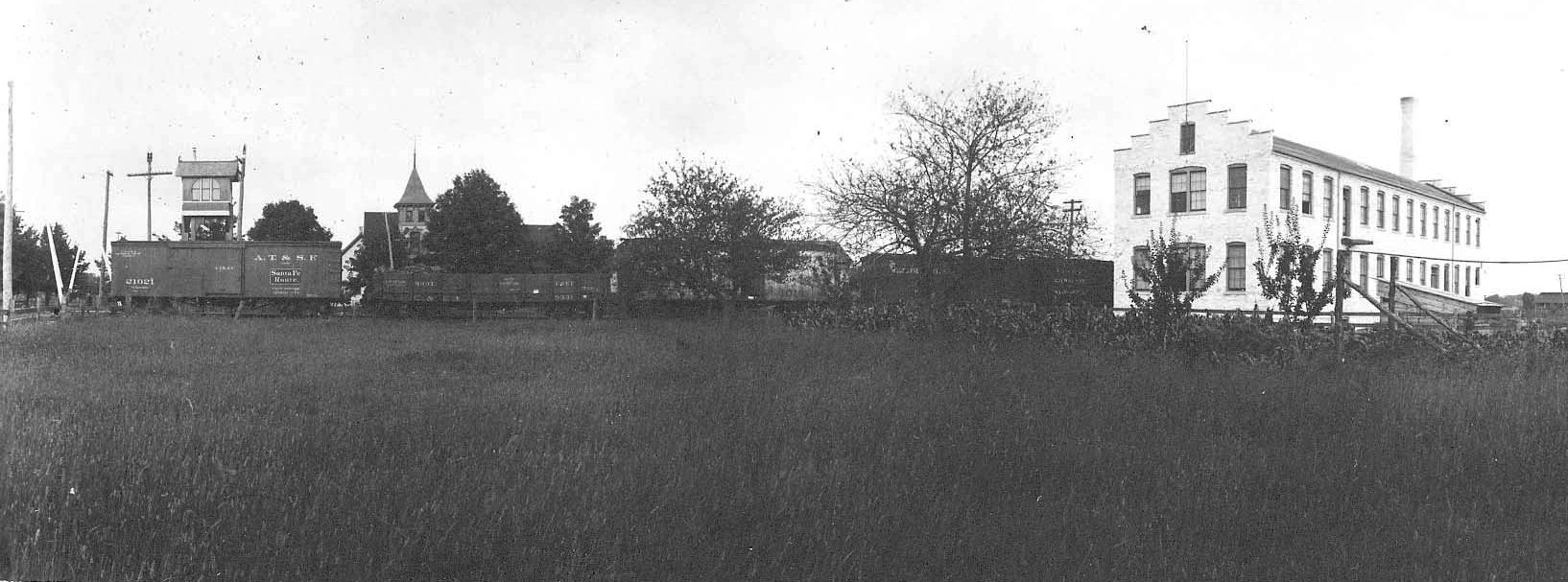
(The Al-Vista factory building (right) was located on the south side of Jefferson Street near the railroad tracks. The building was razed after a fire in 1910. Today, the Fox River State Bank building occupies a portion of the property closer to Jefferson Street.)
Smith and Partee, who had assumed control of the Multiscope & Film Co., moved into a newly constructed building on the corner of Pine and Washington streets (now occupied by Flippy’s), where they engaged in the wholesale photographic supply business. They also established branches in Chicago and Fargo, North Dakota. In 1910 the company’s headquarters was moved to Chicago and the name was changed to Partee Photo Supply Co. Other interests gradually dwindled away and, as the Multiscope & Film Co. had outlived its usefulness, it was decided to file articles of dissolution.
In May 1915 the Multiscope & Film Co. ceased to exist as a Wisconsin corporation. It had stopped doing business some two years earlier.
- - - - -
The Al-Vista camera, made by the Multiscope & Film Co., is shaped like a rectangular box and was made in different sizes. A popular model was about 6"x5"x12". The lens, framed by a dark velvet cloth, is mounted on a clockwork which can turn it at a 160 degree angle. The speed of the lens revolution can be varied by small sets of 24 different fans, mounted outside the camera box. To produce clear pictures, the camera had to be mounted on a tripod.
A button on the camera enables the photographer to take, instead of a single 160 degree picture, several “sequence” pictures adding up to a 160 degree width.
(An Al-Vista camera from the Society's collection is shown at left. A rectangular fan is on top of the camera left of center. A preview "eye" is right of center.)
City Celebrates End of War - 70 Years Ago
The following article is adapted from the accounts in the two Burlington newspapers of the time – the Free Press of August 16, 1945, and the Standard Democrat of August 17, 1945.
JAPAN SURRENDERS
Japan on Tuesday, August 14, unconditionally surrendered, ending the war that had been raging since Pearl Harbor on December 7, 1941.
The surrender came after four days of suspense while Japan was considering the ultimatum issued by President Harry S Truman in behalf of the allies.
President Truman made the announcement at the White House at 6 o’clock central time Tuesday evening and in a few minutes radio had spread the news to a waiting world.
“I have received this afternoon a message from the Japanese government in reply to the message forwarded to that government by the secretary of state on August 11.
“I deem this reply is full acceptance of the Potsdam declaration which specifies the unconditional surrender of Japan. In this reply there is no qualification.
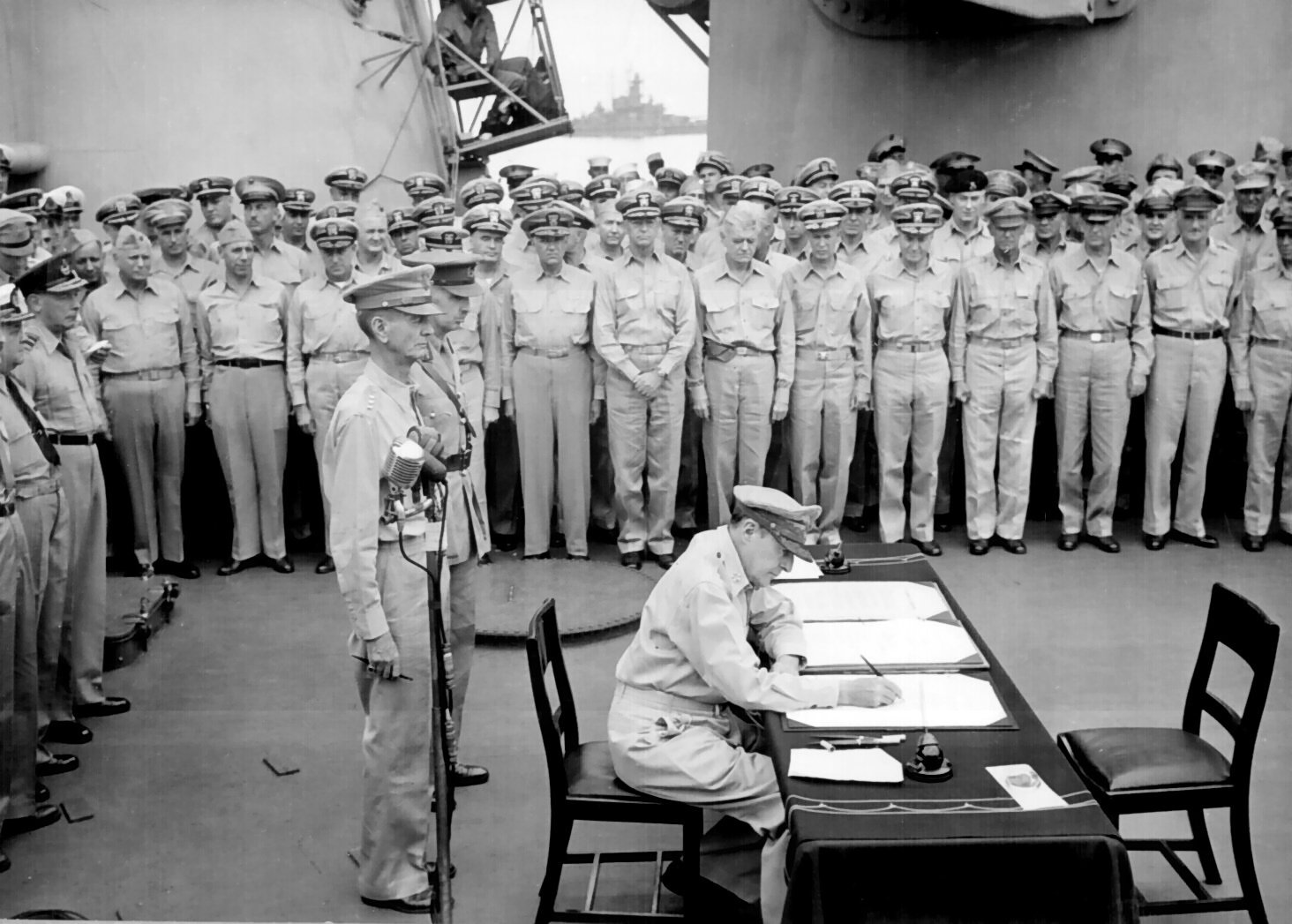
“Arrangements are now being made for the formal signing of surrender terms at the earliest possible moment.
“General Douglas MacArthur has been appointed the supreme commander to receive the Japanese surrender.
“Great Britain, Russia and China will be represented by high ranking officers.
“Meanwhile, the allied armed forces have been ordered to suspend offensive action.
“The proclamation of V-J day must wait upon the formal signing of the surrender terms by Japan.”
Left: General Douglas MacArthur, Supreme Commander of the Allied Powers, accepts Japan's formal surrender aboard the USS Missouri, anchored in Tokyo Bay.
Burlington Celebration
Burlington celebrated the victory noisily and happily Tuesday night.
News that our nation was again at peace came just as families were about to begin the evening meal. Seconds after the announcement at 6 p.m., pealing church bells rang out the first "HALLELUJAH!" Soon the city’s whistles and sirens joined the shouts of victory. Telephone lines were jammed as callers tried to exchange a few jubilant words with relatives and friends.
Faces that had been tense for days from the strain of uncertainty relaxed with joy at the realization that there was no more war. Many spent the first few moments of victory in a solemn prayer of thanksgiving, and for many the beauty of the flaming evening sunset took on special significance.
Dinners were left untouched as citizens ran to front sidewalks or hopped into automobiles to rush, honking and beeping their horns, to the downtown section.
By 6:30 the downtown streets were filled with noisy celebrants who poured from all sections of the city. Jubilant motorists opened doors to anyone who wanted to ride, and drove happily round and round the downtown streets, shouting greetings to bystanders hardly audible above the noise of the horns.
Shredded newspapers filled the air and blanketed the streets as the Burlington band assembled for an impromptu concert in front of the Badger Hotel. Celebrants clapped hands and moved their feet to the vigorous rhythm of the drums and cymbals. A few couples began to dance merrily and joyous youngsters began a snake dance on the street.ToJo
After a word in the ear of the band leader, the band started marching down Chestnut to Pine and Washington – and the crowd that followed it was typical of a city that was joyous enough to laugh and dance and sing and shout and run with their dogs after them while they followed the band! So many paraders joined in that the curbstones, formerly jammed, were thinned to little clusters and a few onlookers perched on top of cars. Nobody knew where the band was going or why, but when they got to the corner of Washington and Pine, they found out.
Mayor Roy Hoffman appeared astride a white horse that some of the men of Burlington had “adopted for the occasion” and the victory parade continued. With the band playing triumphal marches, hundreds of celebrants joined hands and marched after. Some in the giddy throng then led the Mayor and the horse into two of the downtown bars – where beer from a huge mug was poured into the mouth of the horse as well as into the mouths of all around him!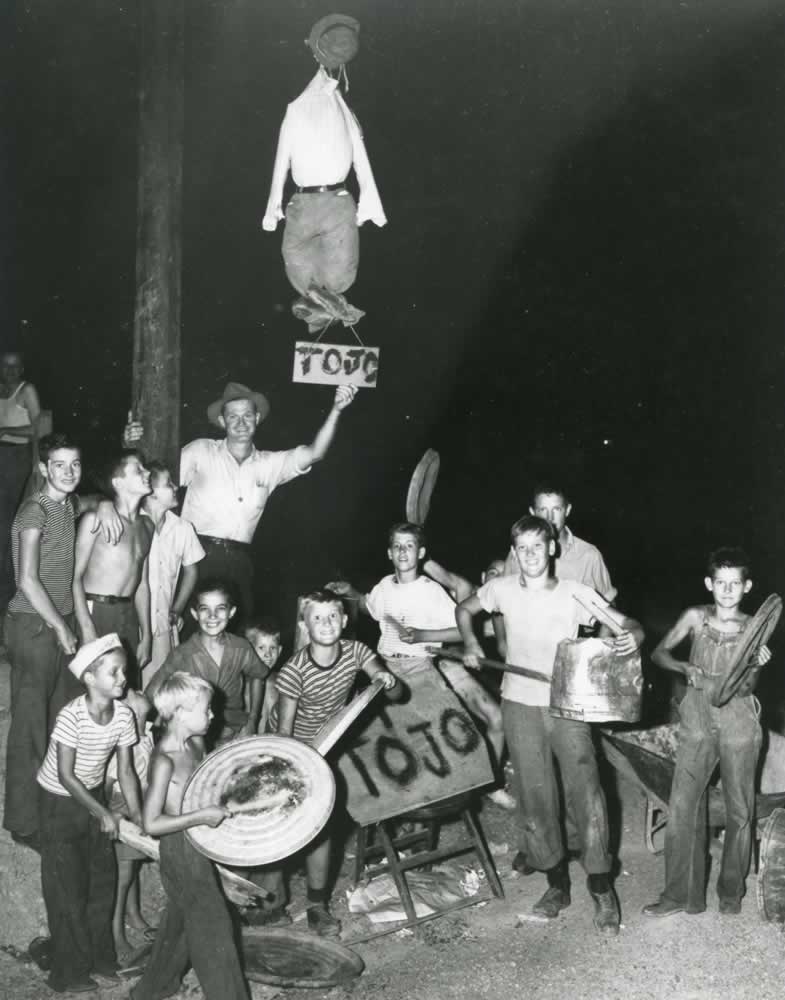
A young man clasped an effigy of Hirohito with a pumpkin for a head, and that effigy and an effigy of Hitler were burned. Joyous children clanged cowbells and banged on cymbals. Behind, a bedlam of hundreds of children and older folks ran, walked, and danced down the littered streets.
It was still early when the tired crowd, their happy faces lit by the flickering bonfires at street intersections, began to disperse. Most of the celebrants left the littered streets to take part in quiet home celebrations with neighbors and friends.
Wednesday was observed as V-J day. All factories and business places were closed all day.
Boys gather under an effigy named “Tojo” during a V-J Day celebration at Oak Ridge,
Tennessee. In Burlington, effigies of Hirohito and Hitler were burned.
(Ed Westcott photo - tumblr.com)
60 Years Ago . . .
• In 1955 two Burlington firms, the Wagner Specialty Co. and Belle City Appliance Co., were producing half of the world’s supply of bull rings.
• The final issue of the Free Press was dated May 24 and the last issue of the Standard Democrat was dated May 26, 1955. The Standard bought the Free Press and the name was changed to Standard-Press, with the first issue dated June 2.
• The House of Representatives’ Armed Services Committee authorized an Air Force jet interceptor base for the Burlington-Kansasville area. The base, never finished, was named for Medal of Honor recipient Major Richard I. Bong of Poplar, Wis.

